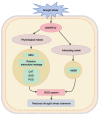MdGRF22, a 14-3-3 Family Gene in Apple, Negatively Regulates Drought Tolerance via Modulation of Antioxidant Activity and Interaction with MdSK
- PMID: 40647977
- PMCID: PMC12252163
- DOI: 10.3390/plants14131968
MdGRF22, a 14-3-3 Family Gene in Apple, Negatively Regulates Drought Tolerance via Modulation of Antioxidant Activity and Interaction with MdSK
Abstract
The 14-3-3 proteins play crucial roles in regulating plant growth, development, signal transduction and abiotic stress responses. However, there exists a scarcity of research on the role of 14-3-3 proteins in responding to abiotic stress in apples. In this study, we isolated the MdGRF22 gene from the apple 14-3-3 family. Through the screening of interacting proteins and genetic transformation of Arabidopsis thaliana and apple callus tissues, the function of the MdGRF22 gene under drought stress was verified. The coding sequence (CDS) of MdGRF22 consists of 786 bp and encodes for 261 amino acids. Through sequence alignment, the conserved 14-3-3 domain was identified in MdGRF22 and its homologous genes, which also share similar gene structures and conserved motifs. Subcellular localization revealed that the MdGRF22 protein was predominantly located in the cytoplasm and cell membrane. The yeast two-hybrid (Y2H) analysis demonstrated a possible interaction between MdGRF22 and MdSK. In addition, MdGRF22 transgenic plants generally exhibited lower superoxide dismutase (SOD), catalase (CAT) and peroxidase (POD) activities, higher malondialdehyde (MDA) levels and relative electrolyte leakage under drought conditions compared with wild-type (WT) plants. Our study suggests that MdGRF22 may reduce the drought resistance of transgenic A. thaliana and callus tissues by interacting with MdSK. This study provides a theoretical basis for further exploring the function of 14-3-3 family genes.
Keywords: MdGRF22; Y2H; antioxidant system; apple.
Conflict of interest statement
The authors declare no conflicts of interest.
Figures






Similar articles
-
Overexpression of a Malus baccata (L.) Borkh WRKY Factor Gene MbWRKY33 Increased High Salinity Stress Tolerance in Arabidopsis thaliana.Int J Mol Sci. 2025 Jun 18;26(12):5833. doi: 10.3390/ijms26125833. Int J Mol Sci. 2025. PMID: 40565296 Free PMC article.
-
Evolution analysis of GH3 gene family in five Rosaceae species and FaGH3.17, FaGH3.18 improve drought tolerance in transgenic Arabidopsis.BMC Plant Biol. 2025 Jul 2;25(1):815. doi: 10.1186/s12870-025-06689-2. BMC Plant Biol. 2025. PMID: 40604382 Free PMC article.
-
Molecular cloning and functional characterization in response to saline-alkali stress of the MhZEP gene in Arabidopsis thaliana.Physiol Mol Biol Plants. 2024 Sep;30(9):1551-1564. doi: 10.1007/s12298-024-01495-w. Epub 2024 Sep 5. Physiol Mol Biol Plants. 2024. PMID: 39310706
-
[Volume and health outcomes: evidence from systematic reviews and from evaluation of Italian hospital data].Epidemiol Prev. 2013 Mar-Jun;37(2-3 Suppl 2):1-100. Epidemiol Prev. 2013. PMID: 23851286 Italian.
-
A systematic review and economic evaluation of epoetin alpha, epoetin beta and darbepoetin alpha in anaemia associated with cancer, especially that attributable to cancer treatment.Health Technol Assess. 2007 Apr;11(13):1-202, iii-iv. doi: 10.3310/hta11130. Health Technol Assess. 2007. PMID: 17408534
References
Grants and funding
LinkOut - more resources
Full Text Sources
Miscellaneous

